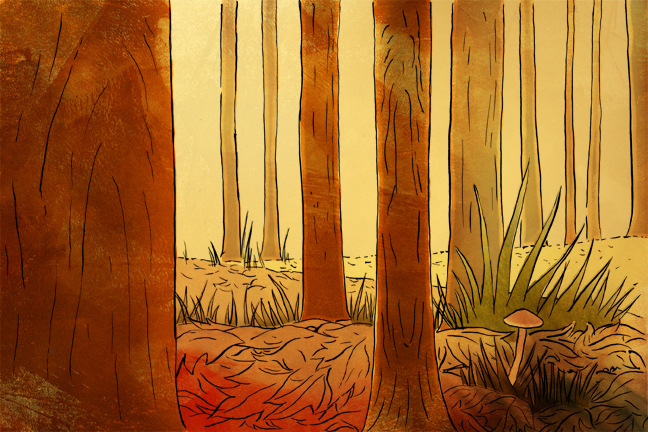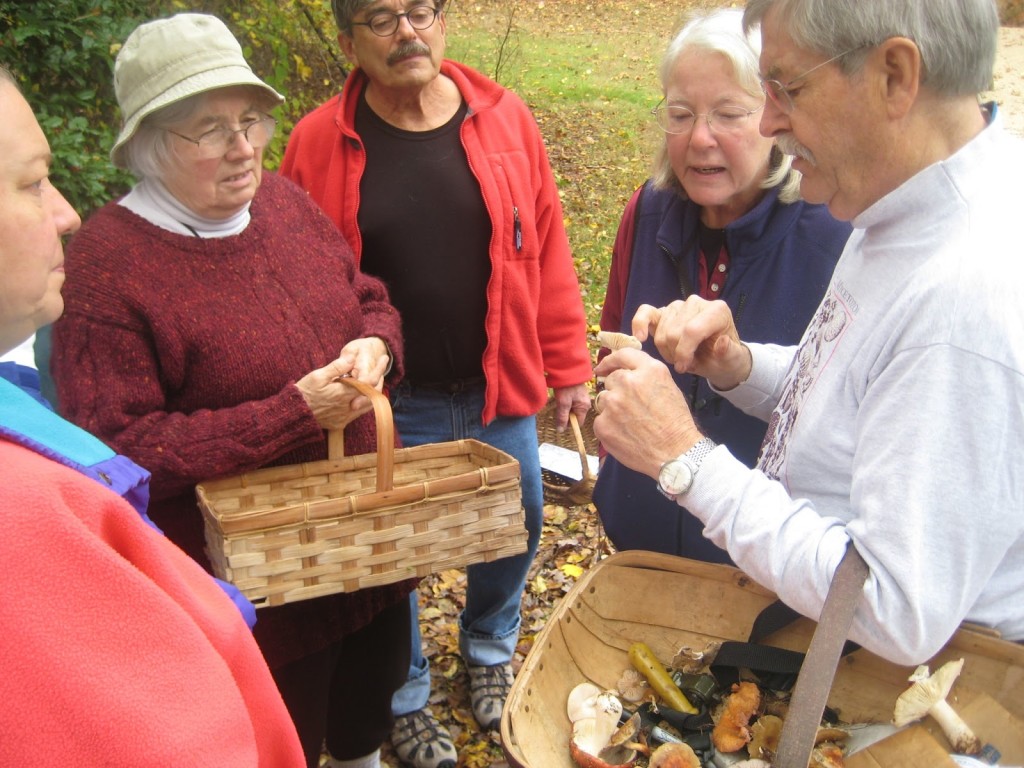
Text published here in full; originally published at Boston University News Service (now archived) on Nov 21, 2012, with accompanying video and infographic.
By XiaoZhi Lim
BU News Service
LINCOLN – It was an hour of trekking in the Lincoln woods with George Davis, a retired chemist and president emeritus of the Boston Mycological Club, before I finally spotted our prey: mushrooms. They were right beneath my feet, almost impossible to distinguish from the fallen leaves that covered the ground. Davis quickly classified the bright yellow mushrooms, with rounded caps and rings around their stems, as Amanita, a group of fungi in which many members are known to be poisonous.
The mushroom walk was hosted by Trish Adams, a Boston Mycological Club member, on a recent Sunday morning at her home in Lincoln, Massachusetts. Adams, now retired, has been hosting these walks, followed by a mushroom-themed potluck, for the club annually for about six years. “I just put in my name,” said Adams, “and thought it would be fun to have lunch, too.” People brought all sorts of mushroom dishes: salads, noodles, quiche, pastry filled with mushrooms and ricotta cheese, and even mushroom-shaped meringues. Most dishes used store-bought mushrooms, but some were made with wild mushrooms.

The Boston Mycological Club, founded in 1895, is the oldest club of its kind in America. According to club president Susan Goldhor, the members are mushroom amateurs with varying interests and backgrounds. “We have the rocket scientists and the plumbers,” said Davis. Over 400 members participate in a variety of club events, including mushroom walks, identification classes, lectures and celebrations. During the summer and fall seasons, the BMC typically holds mushroom walks for its members every Sunday morning, at various locations in the Greater Boston area.
Some BMC members, like Adams, want to be able to pick and eat mushrooms from the woods around their homes. The U.S. has over 3,000 species of mushrooms, and only about 250 species are edible. Americans eat about four pounds of mushrooms per person every year, most of them the bland, white buttons sold in supermarkets. More exotic varieties have appeared on the shelves in recent years. Earthy shiitakes and fleshy portobellos can be found in grocery stores like Shaw’s and Trader Joe’s, while leggy little enokis and flat, stem-less oysters are more commonly seen in Asian supermarkets like Super 88. Relatively few Americans hunt for wild mushrooms, but those who do tend to avoid store-bought mushrooms. It is “very important to use what nature has provided,” said Adams, who has stopped buying mushrooms and only eats what she finds.
Not all BMC members are solely interested in edible mushrooms. Some BMC members are artists who want to learn more about mushroom anatomy in order to draw mushrooms accurately. One distinct group of members, with eastern European heritage, participates to reconnect with their ancestral histories of mushroom foraging. “The people are as interesting as the mushrooms,” said Marcia Jacob, corresponding secretary of the club.
My Sunday mushroom walk was followed up with an identification class on Monday evening at the Harvard Herbaria Seminar Room.
Identifying mushrooms picked during a walk is a large part of the club’s activities and, according to Davis, a “service that is available to people” in the club. Outside the Harvard Herbaria, a sign hung from the door, reading “BMC,” with a buzzer next to it.
I was let in by Jason Karakehian, the club’s librarian, and we were joined by Davis, who brought a basket with about ten specimens of mushrooms to be identified.
“What do you think of this?” said Davis, holding out a brown mushroom with a thick cap and stem.
“Oh, beautiful,” said Karakehian, taking the mushroom from Davis and turning it over to reveal the mushroom’s well-defined gills.
“What is that?”
Identifying mushrooms involves the matching of observed information about a mushroom such as its appearance, smell and taste to documented information in books. It is easy to put the mushroom in a group, but “winnowing it down to a point, the identity,” is very difficult, according to Karakehian. “But you can make a pretty good guess,” said Davis, and the mushroom was classified as a member of the Tricholoma group, based on the groove that it had around its stem where the gills joined the cap.
Karakehian broke the mushroom open and held it to his nose. “It smells like pencils,” he said, handing a mushroom half to me. It did not have the woody, nutty smell of the mushrooms I was familiar with. Instead, it had a synthetic smell that was difficult to place.
Karakehian then bit into the mushroom, chewed it for a while and spat it out.
“Was it bitter?” asked Davis.
“Just a little,” said Karakehian. “It tastes like soap.”
One hour and four fungi books later, Davis copied a name onto a piece of paper. He still needed to Google the name and find more information before he could definitively identify the mushroom. For most amateur mushroom hunters, the things that Davis and Karakehian used to tell if a mushroom is edible or not, are simple things that they can observe. “Things like size, shape, color and smell; things people use without even thinking about it,” said Davis. “But sometimes, you can get fooled.”
A few weeks later, I returned to Adams’s house with two other classmates for a follow-up mushroom walk and interview. Adams had found a small cluster of late fall oyster mushrooms growing on the trunk of a maple tree, and we had the good fortune to film Adams cutting the mushrooms off and bringing them home. Back in Adams’s tidy little kitchen, she quickly separated each oyster mushroom from the group. Without washing them, Adams drizzled olive oil generously over each mushroom before placing it in a box and adding some pressed garlic to marinate. We didn’t stay long enough to see Adams cook the mushrooms, but before we left, she gave us some frozen black trumpets and hens to bring home. That night, we made angel-hair pasta with just the wild mushrooms sautéed in olive oil.
The flavors of the mushrooms were rich and intense, earthy and nutty, and Adams was right: “You don’t need much to flavor a sauce.” Still, it will be a long time before I dare to start hunting for my own mushrooms.